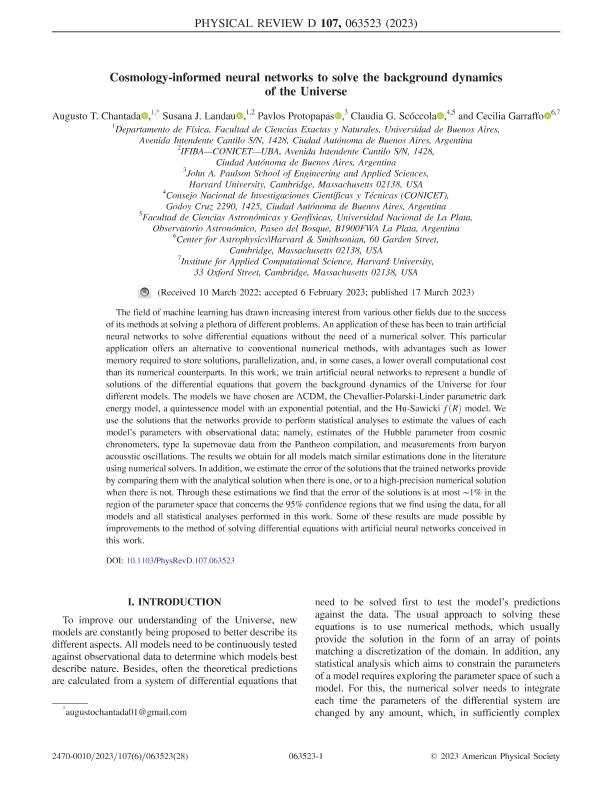Mostrar el registro sencillo del ítem
dc.contributor.author
Chantada, Augusto T.
dc.contributor.author
Landau, Susana Judith

dc.contributor.author
Protopapas, Pavlos

dc.contributor.author
Scoccola, Claudia Graciela

dc.contributor.author
Garraffo, Cecilia

dc.date.available
2024-02-22T14:54:47Z
dc.date.issued
2023-03
dc.identifier.citation
Chantada, Augusto T.; Landau, Susana Judith; Protopapas, Pavlos; Scoccola, Claudia Graciela; Garraffo, Cecilia; Cosmology-informed neural networks to solve the background dynamics of the Universe; American Physical Society; Physical Review D; 107; 6; 3-2023; 1-28
dc.identifier.issn
2470-0010
dc.identifier.uri
http://hdl.handle.net/11336/228073
dc.description.abstract
The field of machine learning has drawn increasing interest from various other fields due to the success of its methods at solving a plethora of different problems. An application of these has been to train artificial neural networks to solve differential equations without the need of a numerical solver. This particular application offers an alternative to conventional numerical methods, with advantages such as lower memory required to store solutions, parallelization, and, in some cases, a lower overall computational cost than its numerical counterparts. In this work, we train artificial neural networks to represent a bundle of solutions of the differential equations that govern the background dynamics of the Universe for four different models. The models we have chosen are ΛCDM, the Chevallier-Polarski-Linder parametric dark energy model, a quintessence model with an exponential potential, and the Hu-Sawicki f(R) model. We use the solutions that the networks provide to perform statistical analyses to estimate the values of each model's parameters with observational data; namely, estimates of the Hubble parameter from cosmic chronometers, type Ia supernovae data from the Pantheon compilation, and measurements from baryon acousstic oscillations. The results we obtain for all models match similar estimations done in the literature using numerical solvers. In addition, we estimate the error of the solutions that the trained networks provide by comparing them with the analytical solution when there is one, or to a high-precision numerical solution when there is not. Through these estimations we find that the error of the solutions is at most ∼1% in the region of the parameter space that concerns the 95% confidence regions that we find using the data, for all models and all statistical analyses performed in this work. Some of these results are made possible by improvements to the method of solving differential equations with artificial neural networks conceived in this work.
dc.format
application/pdf
dc.language.iso
eng
dc.publisher
American Physical Society

dc.rights
info:eu-repo/semantics/openAccess
dc.rights.uri
https://creativecommons.org/licenses/by-nc-sa/2.5/ar/
dc.subject
alternative gravity theories
dc.subject
cosmological parameters
dc.subject
cosmology
dc.subject
dark energy
dc.subject.classification
Astronomía

dc.subject.classification
Ciencias Físicas

dc.subject.classification
CIENCIAS NATURALES Y EXACTAS

dc.title
Cosmology-informed neural networks to solve the background dynamics of the Universe
dc.type
info:eu-repo/semantics/article
dc.type
info:ar-repo/semantics/artículo
dc.type
info:eu-repo/semantics/publishedVersion
dc.date.updated
2024-02-22T11:18:49Z
dc.identifier.eissn
2470-0029
dc.journal.volume
107
dc.journal.number
6
dc.journal.pagination
1-28
dc.journal.pais
Estados Unidos

dc.description.fil
Fil: Chantada, Augusto T.. Universidad de Buenos Aires. Facultad de Ciencias Exactas y Naturales. Departamento de Física; Argentina
dc.description.fil
Fil: Landau, Susana Judith. Consejo Nacional de Investigaciones Científicas y Técnicas. Oficina de Coordinación Administrativa Ciudad Universitaria. Instituto de Física de Buenos Aires. Universidad de Buenos Aires. Facultad de Ciencias Exactas y Naturales. Instituto de Física de Buenos Aires; Argentina
dc.description.fil
Fil: Protopapas, Pavlos. Harvard University. School Of Engineering And Applied Sciences.; Estados Unidos
dc.description.fil
Fil: Scoccola, Claudia Graciela. Universidad Nacional de La Plata. Facultad de Ciencias Astronómicas y Geofísicas; Argentina. Consejo Nacional de Investigaciones Científicas y Técnicas; Argentina
dc.description.fil
Fil: Garraffo, Cecilia. Harvard-Smithsonian Center for Astrophysics; Estados Unidos. Consejo Nacional de Investigaciónes Científicas y Técnicas. Oficina de Coordinación Administrativa Ciudad Universitaria. Instituto de Astronomía y Física del Espacio. - Universidad de Buenos Aires. Facultad de Ciencias Exactas y Naturales. Instituto de Astronomía y Física del Espacio; Argentina
dc.journal.title
Physical Review D
dc.relation.alternativeid
info:eu-repo/semantics/altIdentifier/url/https://link.aps.org/doi/10.1103/PhysRevD.107.063523
dc.relation.alternativeid
info:eu-repo/semantics/altIdentifier/doi/http://dx.doi.org/10.1103/PhysRevD.107.063523
Archivos asociados
